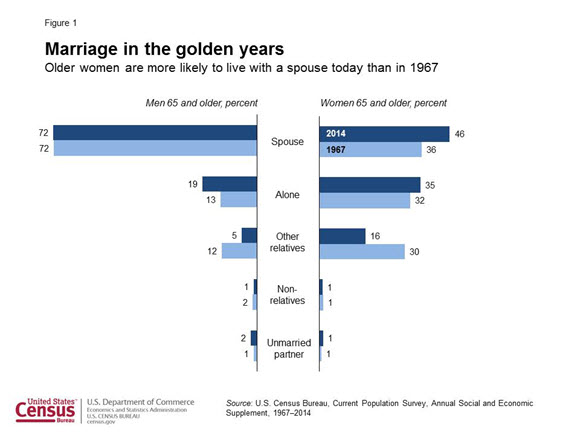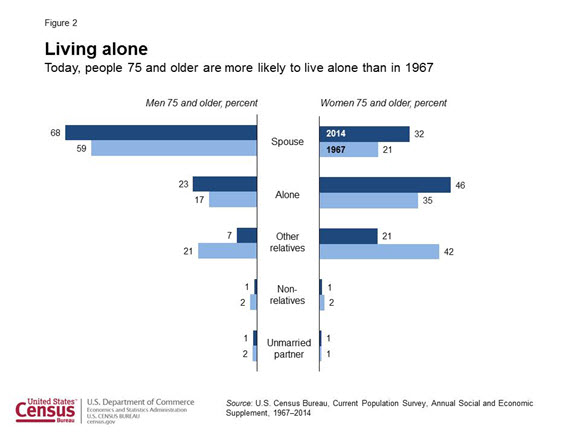
An official website of the United States government
Here’s how you know
Official websites use .gov
A .gov website belongs to an official government organization in the United States.
Secure .gov websites use HTTPS
A lock (
) or https:// means you’ve safely connected to the .gov website. Share sensitive information only on official, secure websites.
-
//
- Census.gov /
- Census Blogs /
- Random Samplings /
- A Gray Revolution in Living Arrangements
A Gray Revolution in Living Arrangements
A Gray Revolution in Living Arrangements
The last 50 years have witnessed a revolution in young adult living arrangements, which are now more diverse than at any time since World War II. The transformation is not limited to young adults, however. Today’s older adults, defined here as 65 and older, are more likely to live alone or with an unmarried partner than previous generations (see Figure 1). Surprisingly, they’re also the only age group where living with a spouse is more common today than 50 years ago — every other age group has witnessed a substantial decline in marriage.
Older adults have experienced the biggest gains in living with a spouse, but not because they’re rushing to the altar. Older women’s husbands are living longer. Men live 10 years longer [PDF 7.3 MB], on average, than they did 50 years ago. Rising life expectancy helps explain why older adults are the only age group to have seen an increase in living with a spouse.
This is not to say rising tides lift all boats, for living with a spouse is far more common among older men. About three quarters of older men live with a spouse, but only about half of women 65 and older, and a third of women 75 and older do so (see Figure 2). Why the difference? Older women are more likely to be widowed because of men’s higher mortality rates. Once widowed, older women are also more likely to remain unmarried because men tend to marry younger women [XLS <1.0 MB].
Another part of this gray revolution is the steep decline in living with other relatives. Living alone has instead replaced living with other relatives as the most common arrangement for women 75 and older (see Figure 2); today almost half of these women live alone. An older woman who moved in with an adult child or sibling in 1967 may now find it’s more acceptable to live on her own, and that she has the ability to do so, whether because of Social Security, Medicare, homeownership or other resources.
Probably the biggest unforeseen transformation has been the rise in older adults who are cohabiting, that is living with a romantic partner without being married. Older cohabitors have increased more than fourfold since 1967, to over 750,000 people today. To be sure, older cohabitors are still rare, totaling just 2 percent of adults 65 and older. But we’d expect their numbers to keep rising because baby boomers are more likely than prior generations to be never married or divorced as they enter older adulthood, and as of 2014 only the earliest boomers, born between 1946 and 1949, have reached age 65. Many more will follow in the coming years, swelling the size of the older population and transforming later-life living arrangements. For more information visit:
Share
 Yes
Yes
 No
NoComments or suggestions?


Top


